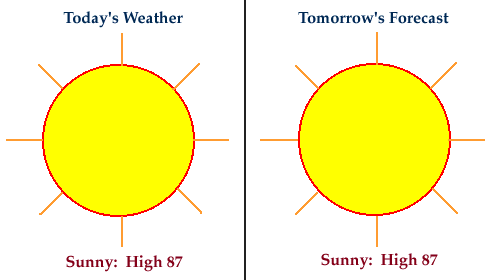|
|
. |
Persistence Method
today equals tomorrow
There are several different methods that can be used to create a
forecast. The method a forecaster chooses depends upon the experience
of the forecaster, the amount of information available to the forecaster,
the level of difficulty that the forecast situation presents, and the degree
of accuracy or confidence needed in the forecast.
The first of these methods is the
Persistence Method; the simplest way of producing a
forecast. The persistence method assumes that the conditions at the time of the
forecast will not change.
For example, if it is sunny and 87 degrees today, the persistence
method predicts that it will be sunny and 87 degrees tomorrow.
If two inches of rain fell today, the persistence method would predict
two inches of rain for tomorrow.

The persistence method works well when weather patterns
change very little
and features on the weather maps move very slowly. It also
works well in places like southern California, where summertime
weather
conditions vary little from day to day.
However, if weather conditions change significantly from
day to day, the persistence method usually breaks down and is
not the best forecasting method to use.
It may also appear that the persistence method would work only for
shorter-term forecasts (e.g. a forecast for a day or two), but actually one
of the most useful roles of the persistence forecast is predicting long
range weather conditions or making climate forecasts. For example, it is
often the case that one hot and dry month will be followed by another hot
and dry month. So, making persistence forecasts for monthly and
seasonal weather conditions can have some skill. Some of the other
forecasting methods, such as
numerical weather prediction,
lose all
their skill for forecasts longer than 10 days. This makes persistence
a "hard to beat" method for forecasting longer time periods.

Weather Forecasting
|
|

trends
|
|


